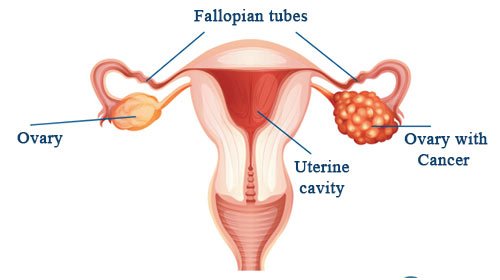Ovarian Cancer

Ovarian cancer is a malignant growth of cells in the ovaries. The cells multiply quickly and have the potential to infiltrate and destroy healthy body tissue. In the female reproductive system, there are two ovaries, one on each side of the uterus. The ovaries, which are about the size of an almond, produce eggs (ova) as well as the hormones estrogen and progesterone. Ovarian cancer is often treated with surgery and chemotherapy.
Although it is uncertain what causes ovarian cancer, scientists have discovered risk factors for the disease. Ovarian cancer arises when the DNA of cells in or around the ovaries changes (mutates). A cell’s DNA contains instructions that tell the cell what to do. The alterations direct the cells to multiply and expand fast, resulting in a mass (tumor) of cancer cells. Malignant cells survive when healthy ones perish. They may infiltrate surrounding tissues and break away from the initial tumor in order to spread (metastasize) to other parts of the body.
The kind of cell in which the illness originates determines the type of ovarian cancer you have and helps your doctor in identifying which medicines will be most beneficial for you.
Types of ovarian cancer include:
Ovarian epithelial cancer. This is the most prevalent kind. There are various subtypes of serous carcinoma and mucinous carcinoma.
Tumors of the stroma. These uncommon tumors are often detected at an earlier stage than other types of ovarian cancer.
Tumors of germ cells. These uncommon ovarian cancers tend to strike at a younger age.

When ovarian cancer initially appears, there may be no visible symptoms. When signs of ovarian cancer appear, they are generally ascribed to other, more prevalent illnesses. As a result, a thorough examination by a specialized doctor is critical to determining whether or not it is ovarian cancer.
Once the diagnosis has been established and medical treatment has begun, the patient might consider beginning professional Chakra Therapy to enhance and speed up recovery while providing holistic and ultimate healing.

Swadhisthana Chakra also known as Sacral Chakra controls the way you think and feel. When the Swadhisthana Chakra is optimally active or energized, you are fearless by nature. You become creative, safe and protected. But when it becomes imbalanced when a person is unaware of the care and nurturing provided by their surroundings. Because he or she believes he or she is not deserving of or good enough to achieve anything in life, he or she has self-doubt. They also believe they are unloved and uncared for, and they blame themselves or others for feeling unloved. Among the many things that may cause this chakra to become blocked are self-doubt, poor self-worth, dread of the unknown, and worry that something bad will happen to me, to name a few. Once this Chakra is balanced, the person is free of self-doubt, and the prognosis of ovarian cancer significantly improves.

Chakra Therapy is a unique technique to open the blocked Chakras in the body and treat the ailments caused by these blockages. Chakra Therapy is an alternative therapy that does not have any side effects and treats not only the disease but transforms the affected individual to find their purpose in life and face it with renewed energy and vigor.
Chakra therapy opens the Swadhisthana Chakra and with the resulting restored energy and vitality this cancer condition has a much better prognosis.

The ovaries, which are about the size of an olive, are the egg or ovum generating region of a woman’s anatomy. Because they are essentially the life-creating component of our bodies, they are inextricably linked to our creativity. It is critical to understand how we define creativity and how we honor our creative side in our own, sometimes distinct, ways. To some, making a new meal based on one’s own unique take on a recipe is a kind of creative expression, whilst others may only consider ground-breaking original ideas to be creative. When we suffocate all forms of creativity or our self-worth as women is seriously eroded, then we are prone to ovaries ailments and ovarian cancer as the ultimate consequence.

Causes
- Genetics (family history)
- Being overweight or obese
- Postmenopausal hormonal therapy
- Never having been pregnant
- Older age and aging ovaries
Symptoms
- Fatigue
- Back pain
- Weight loss
- Discomfort in the pelvic area
- A frequent need to urinate
- Quickly feeling full when eating
- Abdominal bloating or swelling
Chakra Associated with
- Swadhisthana Chakra
Chakra Blocked By
- Fears, insecurities, guilt and feeling that you are not being appreciated
Chakra Unblocked When
- Being creative and having a trusting nature
Rudraksha for Treating Ovarian Cancer
- 2 and 16 mukhi Rudraksha
Gemstone for Treating Ovarian Cancer
- Pearl

Rudraksha Ratna Science Therapy (RRST) uses specific Rudraksha and Ratna (gemstone) in precise advanced stringing methodology for chakra awakening and healing.
A blocked Swadhisthana Chakra can be opened with the use of Rudraksha, gemstones and other techniques. Choosing the appropriate Rudraksha and Ratna as well as wearing them as per RRST methodology unblocks the Sacral Chakra and significantly helps to prevent and control an ovarian cancer.






